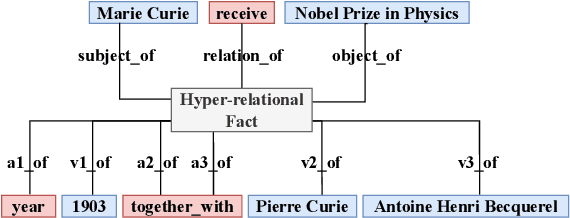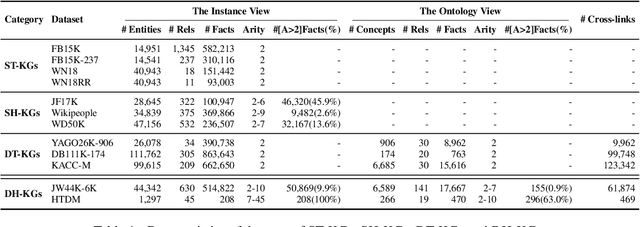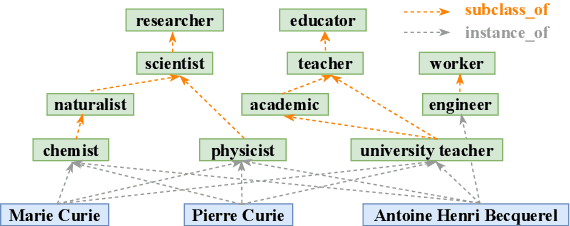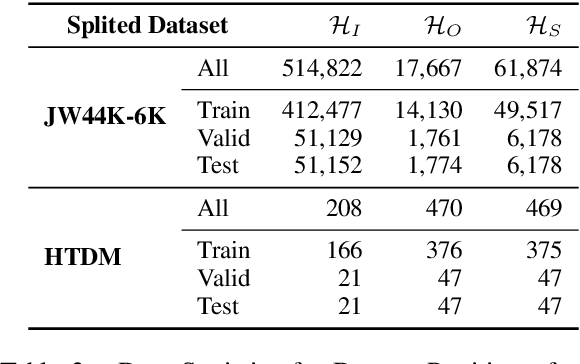Haihong E
FinMMR: Make Financial Numerical Reasoning More Multimodal, Comprehensive, and Challenging
Aug 06, 2025Abstract:We present FinMMR, a novel bilingual multimodal benchmark tailored to evaluate the reasoning capabilities of multimodal large language models (MLLMs) in financial numerical reasoning tasks. Compared to existing benchmarks, our work introduces three significant advancements. (1) Multimodality: We meticulously transform existing financial reasoning benchmarks, and construct novel questions from the latest Chinese financial research reports. FinMMR comprises 4.3K questions and 8.7K images spanning 14 categories, including tables, bar charts, and ownership structure charts. (2) Comprehensiveness: FinMMR encompasses 14 financial subdomains, including corporate finance, banking, and industry analysis, significantly exceeding existing benchmarks in financial domain knowledge breadth. (3) Challenge: Models are required to perform multi-step precise numerical reasoning by integrating financial knowledge with the understanding of complex financial images and text. The best-performing MLLM achieves only 53.0% accuracy on Hard problems. We believe that FinMMR will drive advancements in enhancing the reasoning capabilities of MLLMs in real-world scenarios.
Graph-R1: Towards Agentic GraphRAG Framework via End-to-end Reinforcement Learning
Jul 29, 2025Abstract:Retrieval-Augmented Generation (RAG) mitigates hallucination in LLMs by incorporating external knowledge, but relies on chunk-based retrieval that lacks structural semantics. GraphRAG methods improve RAG by modeling knowledge as entity-relation graphs, but still face challenges in high construction cost, fixed one-time retrieval, and reliance on long-context reasoning and prompt design. To address these challenges, we propose Graph-R1, an agentic GraphRAG framework via end-to-end reinforcement learning (RL). It introduces lightweight knowledge hypergraph construction, models retrieval as a multi-turn agent-environment interaction, and optimizes the agent process via an end-to-end reward mechanism. Experiments on standard RAG datasets show that Graph-R1 outperforms traditional GraphRAG and RL-enhanced RAG methods in reasoning accuracy, retrieval efficiency, and generation quality.
FinanceReasoning: Benchmarking Financial Numerical Reasoning More Credible, Comprehensive and Challenging
Jun 06, 2025Abstract:We introduce FinanceReasoning, a novel benchmark designed to evaluate the reasoning capabilities of large reasoning models (LRMs) in financial numerical reasoning problems. Compared to existing benchmarks, our work provides three key advancements. (1) Credibility: We update 15.6% of the questions from four public datasets, annotating 908 new questions with detailed Python solutions and rigorously refining evaluation standards. This enables an accurate assessment of the reasoning improvements of LRMs. (2) Comprehensiveness: FinanceReasoning covers 67.8% of financial concepts and formulas, significantly surpassing existing datasets. Additionally, we construct 3,133 Python-formatted functions, which enhances LRMs' financial reasoning capabilities through refined knowledge (e.g., 83.2% $\rightarrow$ 91.6% for GPT-4o). (3) Challenge: Models are required to apply multiple financial formulas for precise numerical reasoning on 238 Hard problems. The best-performing model (i.e., OpenAI o1 with PoT) achieves 89.1% accuracy, yet LRMs still face challenges in numerical precision. We demonstrate that combining Reasoner and Programmer models can effectively enhance LRMs' performance (e.g., 83.2% $\rightarrow$ 87.8% for DeepSeek-R1). Our work paves the way for future research on evaluating and improving LRMs in domain-specific complex reasoning tasks.
HyperGraphRAG: Retrieval-Augmented Generation with Hypergraph-Structured Knowledge Representation
Mar 27, 2025Abstract:While standard Retrieval-Augmented Generation (RAG) based on chunks, GraphRAG structures knowledge as graphs to leverage the relations among entities. However, previous GraphRAG methods are limited by binary relations: one edge in the graph only connects two entities, which cannot well model the n-ary relations among more than two entities that widely exist in reality. To address this limitation, we propose HyperGraphRAG, a novel hypergraph-based RAG method that represents n-ary relational facts via hyperedges, modeling the complicated n-ary relations in the real world. To retrieve and generate over hypergraphs, we introduce a complete pipeline with a hypergraph construction method, a hypergraph retrieval strategy, and a hypergraph-guided generation mechanism. Experiments across medicine, agriculture, computer science, and law demonstrate that HyperGraphRAG outperforms standard RAG and GraphRAG in accuracy and generation quality.
KBQA-o1: Agentic Knowledge Base Question Answering with Monte Carlo Tree Search
Jan 31, 2025



Abstract:Knowledge Base Question Answering (KBQA) aims to answer natural language questions with a large-scale structured knowledge base (KB). Despite advancements with large language models (LLMs), KBQA still faces challenges in weak KB awareness, imbalance between effectiveness and efficiency, and high reliance on annotated data. To address these challenges, we propose KBQA-o1, a novel agentic KBQA method with Monte Carlo Tree Search (MCTS). It introduces a ReAct-based agent process for stepwise logical form generation with KB environment exploration. Moreover, it employs MCTS, a heuristic search method driven by policy and reward models, to balance agentic exploration's performance and search space. With heuristic exploration, KBQA-o1 generates high-quality annotations for further improvement by incremental fine-tuning. Experimental results show that KBQA-o1 outperforms previous low-resource KBQA methods with limited annotated data, boosting Llama-3.1-8B model's GrailQA F1 performance to 78.5% compared to 48.5% of the previous sota method with GPT-3.5-turbo.
ChatKBQA: A Generate-then-Retrieve Framework for Knowledge Base Question Answering with Fine-tuned Large Language Models
Oct 13, 2023Abstract:Knowledge Base Question Answering (KBQA) aims to derive answers to natural language questions over large-scale knowledge bases (KBs), which are generally divided into two research components: knowledge retrieval and semantic parsing. However, three core challenges remain, including inefficient knowledge retrieval, retrieval errors adversely affecting semantic parsing, and the complexity of previous KBQA methods. In the era of large language models (LLMs), we introduce ChatKBQA, a novel generate-then-retrieve KBQA framework built on fine-tuning open-source LLMs such as Llama-2, ChatGLM2 and Baichuan2. ChatKBQA proposes generating the logical form with fine-tuned LLMs first, then retrieving and replacing entities and relations through an unsupervised retrieval method, which improves both generation and retrieval more straightforwardly. Experimental results reveal that ChatKBQA achieves new state-of-the-art performance on standard KBQA datasets, WebQSP, and ComplexWebQuestions (CWQ). This work also provides a new paradigm for combining LLMs with knowledge graphs (KGs) for interpretable and knowledge-required question answering. Our code is publicly available.
Text2NKG: Fine-Grained N-ary Relation Extraction for N-ary relational Knowledge Graph Construction
Oct 12, 2023Abstract:Beyond traditional binary relational facts, n-ary relational knowledge graphs (NKGs) are comprised of n-ary relational facts containing more than two entities, which are closer to real-world facts with broader applications. However, the construction of NKGs still significantly relies on manual labor, and n-ary relation extraction still remains at a course-grained level, which is always in a single schema and fixed arity of entities. To address these restrictions, we propose Text2NKG, a novel fine-grained n-ary relation extraction framework for n-ary relational knowledge graph construction. We introduce a span-tuple classification approach with hetero-ordered merging to accomplish fine-grained n-ary relation extraction in different arity. Furthermore, Text2NKG supports four typical NKG schemas: hyper-relational schema, event-based schema, role-based schema, and hypergraph-based schema, with high flexibility and practicality. Experimental results demonstrate that Text2NKG outperforms the previous state-of-the-art model by nearly 20\% points in the $F_1$ scores on the fine-grained n-ary relation extraction benchmark in the hyper-relational schema. Our code and datasets are publicly available.
HAHE: Hierarchical Attention for Hyper-Relational Knowledge Graphs in Global and Local Level
May 15, 2023Abstract:Link Prediction on Hyper-relational Knowledge Graphs (HKG) is a worthwhile endeavor. HKG consists of hyper-relational facts (H-Facts), composed of a main triple and several auxiliary attribute-value qualifiers, which can effectively represent factually comprehensive information. The internal structure of HKG can be represented as a hypergraph-based representation globally and a semantic sequence-based representation locally. However, existing research seldom simultaneously models the graphical and sequential structure of HKGs, limiting HKGs' representation. To overcome this limitation, we propose a novel Hierarchical Attention model for HKG Embedding (HAHE), including global-level and local-level attention. The global-level attention can model the graphical structure of HKG using hypergraph dual-attention layers, while the local-level attention can learn the sequential structure inside H-Facts via heterogeneous self-attention layers. Experiment results indicate that HAHE achieves state-of-the-art performance in link prediction tasks on HKG standard datasets. In addition, HAHE addresses the issue of HKG multi-position prediction for the first time, increasing the applicability of the HKG link prediction task. Our code is publicly available.
NQE: N-ary Query Embedding for Complex Query Answering over Hyper-relational Knowledge Graphs
Nov 24, 2022Abstract:Complex query answering (CQA) is an essential task for multi-hop and logical reasoning on knowledge graphs (KGs). Currently, most approaches are limited to queries among binary relational facts and pay less attention to n-ary facts (n>=2) containing more than two entities, which are more prevalent in the real world. Moreover, previous CQA methods can only make predictions for a few given types of queries and cannot be flexibly extended to more complex logical queries, which significantly limits their applications. To overcome these challenges, in this work, we propose a novel N-ary Query Embedding (NQE) model for CQA over hyper-relational knowledge graphs (HKGs), which include massive n-ary facts. The NQE utilizes a dual-heterogeneous Transformer encoder and fuzzy logic theory to satisfy all n-ary FOL queries, including existential quantifiers, conjunction, disjunction, and negation. We also propose a parallel processing algorithm that can train or predict arbitrary n-ary FOL queries in a single batch, regardless of the kind of each query, with good flexibility and extensibility. In addition, we generate a new CQA dataset WD50K-NFOL, including diverse n-ary FOL queries over WD50K. Experimental results on WD50K-NFOL and other standard CQA datasets show that NQE is the state-of-the-art CQA method over HKGs with good generalization capability. Our code and dataset are publicly available.
DHGE: Dual-view Hyper-Relational Knowledge Graph Embedding for Link Prediction and Entity Typing
Jul 18, 2022



Abstract:In the field of representation learning on knowledge graphs (KGs), a hyper-relational fact consists of a main triple and several auxiliary attribute value descriptions, which is considered to be more comprehensive and specific than a triple-based fact. However, the existing hyper-relational KG embedding methods in a single view are limited in application due to weakening the hierarchical structure representing the affiliation between entities. To break this limitation, we propose a dual-view hyper-relational KG (DH-KG) structure which contains a hyper-relational instance view for entities and a hyper-relational ontology view for concepts abstracted hierarchically from entities to jointly model hyper-relational and hierarchical information. In this paper, we first define link prediction and entity typing tasks on DH-KG and construct two DH-KG datasets, JW44K-6K extracted from Wikidata and HTDM based on medical data. Furthermore, We propose a DH-KG embedding model DHGE, based on GRAN encoder, HGNN, and joint learning. Experimental results show that DHGE outperforms baseline models on DH-KG. We also provide an example of the application of this technology in the field of hypertension medication. Our model and datasets are publicly available.
 Add to Chrome
Add to Chrome Add to Firefox
Add to Firefox Add to Edge
Add to Edge